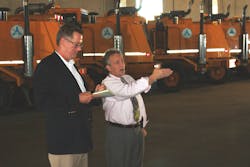I toured the Minneapolis-St. Paul International Airport the day after Labor Day. I knew things were going to work well right from the start: I ran into an old sales rep I hadn’t seen in five years waiting in line at O’Hare for the same flight to the Twin Cities; our flight arrived about 10 minutes early and meeting me at the gate was my fellow colleague Ronald Donner, editor of our sister publication, Aircraft Maintenance Technology, along with Paul Sichko, assistant airport director, MSP operations.
Paul gave us the grand tour for the first couple of hours and I’m pretty sure I saw all 127 gates. I also knew I was in good hands when Paul stopped his truck near a runway just to pick up a piece of paper and, later, what turned out to be a scarf.
“You know you need a vacation when you stop on the highway to do this,” he said.
Along the way, Paul pointed out plenty of interesting tidbits. Like how the new winglet design obviously saves airlines thousands of gallons of jet fuel, but means the airlines need to come up with millions to move the existing fuel hydrant pits since the new wing adds about 10 feet to the old wing’s reach. The new wings have essentially pushed out two gates with a third coming next spring. Or how the airport’s fleet of snow-removal equipment can clear 2 million square feet of runway space in 10 minutes even in a brutal Minnesota winter climate. Or that one runway deicing truck holds 4,000 gallons of potassium acetate at a cost of $4.39 a gallon. Or how if you were to cut out a 25 foot by 25 foot concrete chunk from a runway, what you’d see is a parabolic design that distributes the weight of a jet sideways instead of straight down. I had to ask Paul how many lights were at MSP since my dad spent his career as an electrician at ORD. How many? Approximately, 4,000. There you go dad.
However, what I really wanted to see was ground handling operations. Toward midday Paul turned Ronald and me over to Delta Air Lines and John Herman, senior analyst, airport customer service; Rich Benz, department manager, airport coordination center; and Troy Lindell, performance leader, below wing operations. A few weeks into my tenure, I toured the Dane County Regional Airport in Madison, WI, so it wasn’t the first time I had seen the tough work that goes into ground support. (I remember peering into the metal cave that passes for a baggage hold in Madison and figured my 6-foot 4-inch frame was much better suited to be an editor of a ground support magazine.)
Physically demanding work, I had no doubt. But as we watched one of Troy’s crew on the ramp, I hadn’t thought of how demanding management’s job is to account for turning aircraft throughout the day. Everyone explained the notion of “ground time” – how the ground crew has 45 minutes to take care of every part of everyone’s job. And in case anyone wonders how much time is left, a clock ticks off the minutes.
“We certainly want to get everything turned around as quickly as we can,” John explained. “But if 46 minutes go by, something went wrong and someone is responsible. We have to find out what went wrong and what to do to stop it.”
That’s where John’s work comes into play. He’ll look at data to detect troublesome trends and make the needed adjustments – and keep in mind, Delta handled more than 400 planes the day I was there.
“Almost all aspects of customer service are helped by everyone along the way striving for on-time performance,” John added.
The increasing number of bags checked at the gate continues to be a headache for ground handling – and one not likely to go away since most people are doing this to escape paying a checked baggage fee. I plan to discuss this issue of ground time further in the pages of Ground Support Worldwide.
In the meantime, one more of my takeaways: I’m fascinated by electric pushbacks that can lift up the front wheel of an airplane. These vehicles look like the smallest beasts in the GSE jungle and certainly don’t look like they have the muscle a diesel-powered pushback does.
Later that afternoon, Mark Schneedwind, department manager, ramp operations, Regional Elite Airline Services, took us for a tour of the 240-some Delta Connection flights he oversees day to day. He pointed out a couple of gates where electric is the pushback of choice. While waiting, I noticed a glass-fronted box that contained what looked like a feedbag. Trust me on this one: I’m a farm boy who knows more about the FFA than FAA (that’s “Future Farmers of America” for you city slickers) so I know what these sacks look like. This one contained “Corn Cob Factions,” which Mark told me were used to soak up fuel spills. Interesting to be surrounded by billions of dollars worth of aircraft parked on billions of dollars worth of real estate and find that such a humble product does an effective job.

